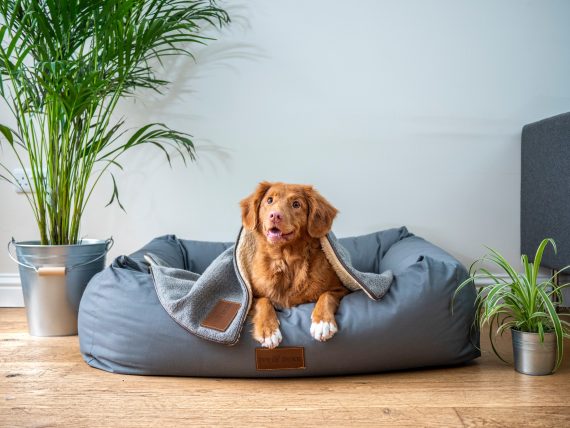9 Ways to Calm your dog during a storm

It is relatively common for dogs to suffer from storm phobia. For many dog owners, they dread the forecast of a thunderstorm. During a storm, dogs can often whine, cry, pant, urinate, pace the house or even be destructive. This behaviour can be stressful for them and can even lead to physical or psychological harm. Here, we share 9 ways to calm your dog during a storm.
Ignore your dog
If a loud sound occurs or any sudden event that might be shocking, do not look at your dog or react in any way towards them as this can tell them there’s a problem and create fear/nervousness or anxiety. Comforting an animal only serves to make us feel better – but it makes the dog worse, some times much worse and very quickly. This is often how phobias are formed. If instead you remain calm and continue with what you are doing you are indicating to your dog that everything is fine. This is the best way to avoid potential fear problems.
Stay at home with your dog
Although this is not always possible if it has been forecasted a large thunderstorm, try and stay at home with your dog, or see if someone else can stay with them. Being alone during a storm can often make the dog more anxious.
Create a calm environment
Find something absorbing to do, that you enjoy and keeps your attention, helping you to stay relaxed. It is important to monitor your own reaction to the storm. Many people suffer from storm phobia themselves. Therefore, try and stay calm during storms, as your dog will notice if you are stressed and this will often make them worse.
Distract your dog
As long as your dog is not stressed try and provide your dog with distractions to try and ensure they do not start to focus on the storm. Try playing an indoor game with them such as fetch, a puzzle toy or a chew toy that they love.
Play music
Although the dog will still be able to hear the storm, try and play some music to help cover some of the noise created from the storm. You can play specific dog calming music, or simply put the radio or TV on as it reduces the impact.
Provide a safe place
If your dog is bothered by the storm they will often try and go to somewhere they feel safe. This could be behind the settee, under a table, under your bed and is very individual. Allow them to go there and leave them be as this is a good sign they are learning to cope. Providing a den type place like a crate or similar gives your dog a good option. Dogs will often stare into space or at walls during these scary events, almost like they are in a trance. This is a good coping strategy and your dog should not be disturbed whilst doing this.
Increase exercise
Before the storm hits, try and get your dog to do more exercise in anticipation. If you time it right, your dog will be tired when the storm hits and this may keep him calmer and may even lead him to fall asleep. However, if you can sense the storm is approaching, avoid taking your dog for a walk as they will be aware of the oncoming storm as well.
Prepare your dog for storms
It is possible to find some thunderstorm sounds, which you can try playing to your dog at low volume. Giving your dog treats / playing games with this as background noise makes it a positive experience. Over time, slowly increase the volume of the storm noises. The aim of this exercise is to desensitise to the sound and hopefully lessen the shock factor when an actual storm occurs.
Try Natural Calmers or Visit your vet
There are many natural calming tablets / sprays / diffusers on the market and these are worth a try – they all work in different ways so you may need to try a few before stumbling on the one that works for your dog. However, If your dog is suffering extremely badly during storms and you have tried the other methods but to no effect, consider visiting your local vet. In severe cases, medication may be the solution. However, medication should always be the last resort, so ensure you have tried all possible methods before choosing to go down this route.
Whilst storms can sound terrifying to your dog and it is understandable why they may be anxious, there are things you can do to successfully reduce this stress. All the methods discussed will vary in success as it completely depends on each individual dog. The best thing to do is to work your way through the list until you find a solution that works for you and your dog. It can be distressing for your dog, but for you as well to watch your dog upset. The main aim is to ensure your dog remains comfortable and as relaxed as possible until the storm subsides.